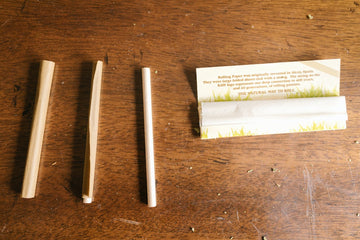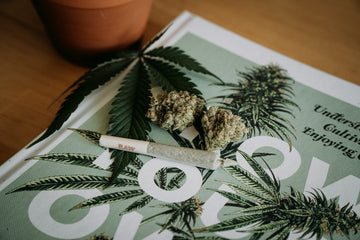What Are Rolling Papers Made Of?
Not all rolling papers are made equal. Depending on what they're made from and the additional ingredients that are used in their production, some rolling papers may be vastly superior to others. In this guide, learn more about the different materials that are used to make rolling papers and how to pick out superior papers for rolling joints or cigarettes. We vigorously tested a variety of materials to find the perfect one for our papers. To see our ingredients list click here.
Types of Rolling Paper Materials
Throughout the history of rolling papers, a wide variety of materials have been used to make joint papers, joint cones, and other types of rolling materials that smokers have come to love. Here are some examples of the most common types of rolling paper materials that have been used historically or that are still on the market today:
1. Rice
Rice is one of the most common rolling paper materials. It was one of the first materials to be used in the mass-production of rolling papers; various top brands of the day switched to rice fiber from wood pulp toward the end of the 1800s, and most of the rolling papers smoked throughout the 20th century were made from rice.
2. Hemp
In recent years, hemp has become an increasingly popular material for making joint papers, and some people even use hemp papers to roll up cigarettes. Smokers like hemp rolling papers due to this material's mild taste and its association with marijuana, and it's surprisingly easy to make hemp rolling papers that are all-natural and organic. Hemp rolling papers consist of dried pulp made from mashed up Cannabis sativa leaves.
3. Wood Pulp
During the early days of rolling papers, most papers were made from wood pulp. To this day, some rolling papers are made from this material, but wood pulp has gradually become less popular due to its harsh taste and the increased likelihood that papers made from this substance will contain toxic ingredients. It's usually possible to identify wood pulp papers based on their thickness and bleached white color.
4. Flax
Flax rolling papers aren't as popular as they used to be, but plenty of brands still use this versatile plant material to make joint papers and joint cones. This all-natural substance is one of the safest types of rolling paper materials, and it is relatively easy to make.
5. Esparto
During the early days of rolling papers in Europe, some Spanish companies made rolling papers from esparto, which is also known as "needle grass." However, esparto rolling papers are incredibly harsh, and they contain more carcinogens than other types of rolling papers.
How Are Rolling Papers Made?
While rolling papers are similar to the types of paper we use for printing and writing, the manufacturing process used to make rolling papers is very different from the process used to make normal paper. The exact process used in the manufacture of rolling papers varies from material to material and manufacturer to manufacturer, but there are a few basic steps that must be followed to make these smoking papers.
1. Harvesting and Processing
Whether they're made from hemp or wood pulp, the process of making rolling papers begins with acquiring the raw materials used in the manufacturing process. Some raw materials are easier to process than others; for instance, hemp leaves are easier to make into paper pulp than hardwood.
2. Forming the Pulp
Once the raw material has been rendered into pulp, it is formed into the shape and thickness of the desired paper. Then, this sheet of pulp is dried until it forms solid paper. Depending on the manufacturer, a number of other steps may be taken to process the resulting paper product.
3. Cutting the Paper
Once a sheet of paper has been made, it is cut into the desired rolling paper shape. During the early days of rolling papers, these papers were cut into single sheets and sold in loose packs. These days, however, it's more common to see rolling papers made in booklets.
3. Assembling the Rolling Papers
Some rolling paper companies may arrange their rolling papers in small booklets that act as dispensers for individual papers. These booklets generally have flaps that shut, and there are quite a few different designs that rolling paper companies may use to make their booklets.
4. Branding and Shipping
Once the finished rolling paper packet has been made, it is branded and shipped to a distribution facility.
Toxic Ingredients to Avoid
If a rolling paper you're considering contains any of these ingredients, choose a different option:
1. Titanium Oxide
In recent years, there have been increasing calls for the manufacturers of cigarettes and rolling papers to make their papers self-extinguishing. Hundreds of homes have burned down because cigarettes have a hard time going out once they've been lit, and the reason for this fire hazard is a chemical called titanium oxide.
Most of the papers used to roll cigarettes contain titanium oxide, which is not only toxic, but it also makes rolling papers burn longer. Back in the day, cigarettes had a habit of going out by themselves, and to solve this problem, cigarette manufacturers started dipping their papers in titanium oxide. The dangers of this ingredient, however, outweigh the benefits.
2. Chlorine Bleach
Many rolling papers have been treated with chlorine bleach to produce a whiter color. This substance is, however, highly toxic, and when it is smoked, it can cause serious respiratory issues. If a rolling paper is made from wood pulp and it is white, chances are that it was treated with bleach.
3. Calcium Carbonate
While cigarette and rolling paper manufacturers want to make sure that their smokes stay lit, they don't want them to burn too fast. Therefore, some rolling paper manufacturers treat their papers with calcium carbonate, which acts as a burn inhibitor. Calcium carbonate is the scientific term for chalk; do you really think that smoking chalk is a good idea?
4. Potassium Nitrate
Blunts and flavored papers are notorious for containing potassium nitrate, which can cause serious respiratory issues. While not all flavored papers contain this toxic substance, it's always good to assume that they do.
5. Artificial Dyes
Some types of rolling papers may contain artificial dyes that are harmful to your health. Make sure that any dyes used in the construction of your desired rolling paper are all-natural and non-carcinogenic.
Harmless Rolling Paper Additives
Not all rolling paper additives are dangerous. Here are some examples of safe rolling paper additives that may add a degree of fun or convenience to your smoking experience:
1. Non-Toxic Soy Coloring
Remember that picture of your grandma that you had printed on a cake for her birthday last year? Some rolling paper companies, such as Empire Rolling, use the same harmless additive that is used to put pictures on cakes to put images on rolling papers. With this technology, it's possible to put the images of hundred dollar bills on your rolling papers or make various other types of money papers.
2. Gum Arabic
Have you ever wondered about that sticky strip at the edge of your rolling papers? This line of adhesive is made from gum arabic, which is a natural derivative from the acacia tree. This additive is non-toxic, and it's also known as sugar gum due to its sweet taste.





















